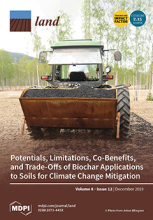Land Library Search
Through our robust search engine, you can search for any item of the over 73,000 highly curated resources in the Land Library.
If you would like to find an overview of what is possible, feel free to peruse the Search Guide.
/ library resources
Showing items 1 through 9 of 15.Environmental pollution is an important issue in metropolitan areas, and roadside trees are directly affected by various sources of pollution to which they exhibit numerous responses.
Urbanization is changing land use–land cover (LULC) transforming green spaces (GS) and bodies of water into built-up areas.
Urbanization poses a major threat to biodiversity worldwide. We focused on birds as a well-studied taxon of interest, in order to review literature on traits that influence responses to urbanization.
The interaction between urbanization and the eco-environment is usually viewed as an effect–feedback framework. Its coupling system is composed of urbanization and eco-environment subsystems.
The complexity of spatial use has an impact on poverty and the development of slum settlements towards a decrease in environmental quality.
Cities have a wide variety of green infrastructure types, such as parks and gardens. These structures can provide important ecosystem services (ES) with a major impact on human well-being.
The concept of a nature-based solution (NBS) has been developed in order to operationalize an ecosystem services approach within spatial planning policies and practices, to fully integrate the ecological dimension, and, at the same time, to address current societal challenges in cities.
This study investigates different provisioning services in the peri-urban landscapes of Manila conurbation through a case study of two villages in the Jala-Jala municipality of the Laguna de Bay area in the Philippines.
Increasing population and rural to urban migration are accelerating urbanization globally, permanently transforming natural systems over large extents.






